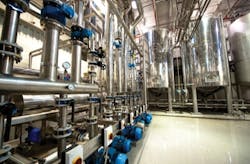Heat Pump Systems Use Wastewater to Lower HVAC Costs
By James Laughlin, WaterWorld Editor
Philadelphia and Chicago both embarked recently on independent programs to test the effectiveness of using the large volume of wastewater at their treatment plants as a heat source in combination with heat pumps to boost performance of heating and cooling systems.
The Philadelphia Water Department and Philadelphia-based NovaThermal Energy have partnered to be the first site in the United States to deploy a commercial scale geothermal system that provides building heat using domestic wastewater. In mid-April Novathermal Energy partners, City and U.S. Department of Energy officials held a ribbon-cutting and tour at the Southeast Water Pollution Control Plant where the project has been implemented.
In early May, a ribbon cutting was held to launch a similar project at the Metropolitan Water Reclamation District of Greater Chicago's James C. Kirie Water Reclamation Plant. That project is a partnership with the University of Illinois at Chicago (UIC) and supported by an $87,500 grant from the Illinois Clean Energy Community Foundation.
The Philadelphia project consists of a 1 million BTU/hr unit located in a basement at the plant. Heat is directly accessed from the adjacent sewage channel. While the technology can be scaled to a much larger size, this project serves to prove the technology's energy savings.
NovaThermal hopes to demonstrate its ability to provide heat at approximately 50% of current cost, realizing $216,000 of savings over 15 years. The company plans to market its patented Chinese technology to any large building located near a major sewer trunk line that contains a steady flow of wastewater still warm from its previous use. In China, several large buildings have successfully employed the technology for heating and air conditioning, including a hotel and a 1-million-square-foot train station in Beijing and a 450,000-square-foot high-rise apartment building in Tianjin, China's third-largest city.
The Philadelphia project was made possible through funding provided by the City of Philadelphia's Greenworks Pilot Energy Technology Grant program, which is supported by federal Energy Efficiency and Conservation Block Grant funds from the U.S. Department of Energy. Ben Franklin Technology Partners of SE Pennsylvania contributed with a grant to support measurement and verification technical assistance.
Heat pump technology is well established. Ground source heat pumps are more efficient than air source systems because they draw heat from the ground or groundwater which is at a relatively constant temperature all year round. This means that the temperature differential is lower, leading to higher efficiency. The same effect is possible from wastewater.
At the Chicago's James C. Kirie Water Reclamation Plant, the effluent has an average temperature of 55 °F. The heat pump system will transfer heat from the effluent to heat the buildings in the winter, and in the summer the heat will be transferred into the water to provide building cooling.
The UIC team worked with the MWRD's Monitoring and Research department to develop a feasibility study for the Kirie WRP, including system design, equipment requirements, historical system data, space requirements and installation.
The Chicago project will compare open and closed loop systems, looking at both efficiency and maintenance requirements over the next year. The closed system circulates treated water in a closed system suspended in a long effluent channel that runs to a receiving stream for discharge. In the open system, treated wastewater is pumped from the effluent channel and then back after passing through the heat pump system.
Catherine O'Connor, Assistant Director in Monitoring and Research at MWRD, said researchers expect the open system to be more efficient and require less energy, but it might have higher maintenance needs.
"We anticipate there will be some algae growth with the open system and want to insure that isn't a problem. We want to understand how much maintenance that would be," she said.
A heat pump system can reduce energy consumption and corresponding emissions up to 44% compared to air-source heat pumps, and up to 72% compared to electric resistance heating with standard air-conditioning equipment, said Commissioner Frank Avila, chairman of MWRD's Board of Commissioners engineering committee during the ribbon-cutting ceremony.
"I am pleased to be here for the activation of an innovative new energy-saving heating and cooling system at this plant that we are calling ‘sewerthermal'," Avila said. "The data we collect could be used to design systems that can easily be applied at our other facilities."
The facility currently uses natural gas for heating and electricity for conventional air conditioning. The heat pump system will serve the 10,000 square foot administration building and is expected to reduce the building's heating and air conditioning costs by 50 percent, Avila said.
Philadelphia Mayor Michael A. Nutter also touted the energy savings possible using the technology.
"I am proud to say that Philadelphia is taking another groundbreaking step in becoming the greenest city in America," said Mayor Nutter. "Partnering with a Philadelphia-based company and using innovative technology, we have achieved a win-win for energy efficiency and economic development. We will be able to save on costs and energy resources at a city facility while commercializing a technology that can be used in large commercial and industrial buildings throughout the country."
O'Connor said heat pumps are a mature technology and this is simple innovation that could be adapted to any wastewater treatment plant that has relatively stable water temperatures. And, it's just one more example of the value that can be obtained from wastewater.
"We are beginning to refocus and understand that we are a resource recovery operation, not wastewater treatment and disposal," she said. "We believe we have a very rich biosolid that should be beneficially reused and we look forward to recovering phosphorus. Now we are recovering heat."
More WaterWorld Current Issue Articles
More WaterWorld Archives Issue Articles


